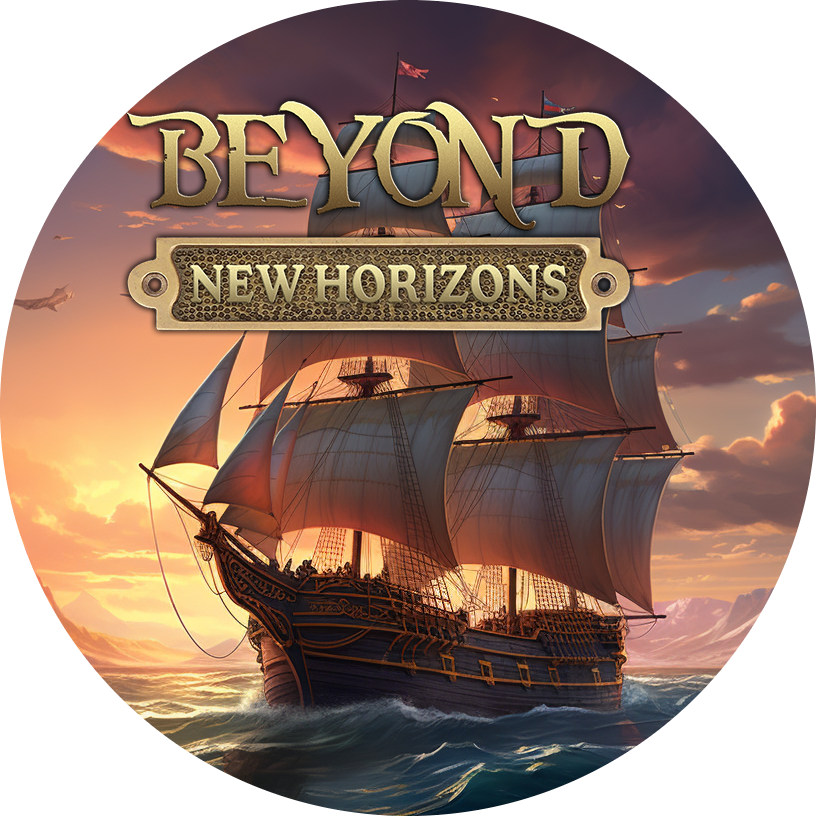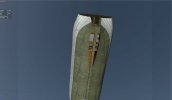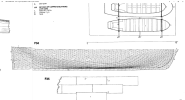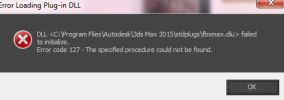Ah, that's why!Indeed it is, that was one of the harder things to get right with hull...had to be just big enough for the flow of water through the paddle but just small enough to not look like a mistake!
-


Visit our website www.piratehorizons.com to quickly find download links for the newest versions of our New Horizons mods Beyond New Horizons and Maelstrom New Horizons!-

Quick links for Beyond New Horizons
- Download latest version
- Wiki - FAQ - Report bugs here - Bug Tracker on Github -

Quick links for Maelstrom
- Download the latest version of Maelstrom
- Download the latest version of ERAS II - Download the latest version of New Horizons on Maelstrom
-

Quick links for PotC: New Horizons
- Download latest version
- Wiki - FAQ - Report bugs here
-

Thanks to YOUR votes, GOG.com now sells:
- Sea Dogs - Sea Dogs: Caribbean Tales
- Sea Dogs: City of Abandoned Ships
Vote now to add Pirates of the Caribbean to the list! -

Quick links for AoP2: Gentlemen of Fortune 2
- Downloads and info
- ModDB Profile
- Forums Archive -

A Pirate Podcast with Interviews
Music, Comedy and all things Pirate!
- Episode Guide - About - Subscribe -
- Twitter - Facebook - iTunes - Android -
- Youtube - Fill the Coffers -
You are using an out of date browser. It may not display this or other websites correctly.
You should upgrade or use an alternative browser.WIP Steam Gunboat
- Thread starter Robert Nutter
- Start date
We (as in, me and @Armada) discussed this at some length as the original plans are a little confusing; it seems it had a 'channel' for the water going through the middle of the hull, almost like a catamaran astern. Obviously I couldn't do that 100% due to tri count, but do you think it's something players will notice and take issue with, or not really matter?
Here's the dorsel view:
 Last edited:
Last edited:
Let's see how this will end up looking in the game. And if we think it fine and players still report it, we can just explain it.We (as in, me and @Armada) discussed this at some length as the original plans are a little confusing; it seems it had a 'channel' for the water going through the middle of the hull, almost like a catamaran astern. Obviously I couldn't do that 100% due to tri count, but do you think it's something players will notice and take issue with, or not really matter?
They might learn something! @Robert Nutter, the main problem I can see is that the copper sheathing seems to be mounted perpendicular to the planking lines?
@Robert Nutter, the main problem I can see is that the copper sheathing seems to be mounted perpendicular to the planking lines?
As far as I know, copper sheathing is supposed to look like this, according to a reference for the Bellona:

Also, the bow section of the keel should be textured with plain wood above the waterline; I suggest the same wood that you used on the stern.@Robert Nutter, the main problem I can see is that the copper sheathing seems to be mounted perpendicular to the planking lines?
I can fix that easily enough, and from what I can tell it's mostly on the stern that it isn't perpendicular? Would you also recommend that the plates themselves are smaller? Only I did it like this as in some references I've seen them done a lot like Iron plating, I think to minimize the possibility of seams coming apart.
Also, the bow section of the keel should be textured with plain wood above the waterline; I suggest the same wood that you used on the stern.
I had it like that before, but got concerned that splitting the polys to allow for the multiple materials issue would cause problems further down the road? Perhaps if I create a new mesh from said polys that could work...I'm also having an issue at the moment with exporting to the preferred FBX...C4D crashes to desktop, OBJ also gives me numerous grouping issues when I try in Maya now so I'm going to have to use DAE, which doesn't seem to understand the materials once it's into Maya 2016. Lord knows how 5 will deal with it!Last edited:
Yes, I think smaller plates would look better. Although I'm not familiar with how copper sheathing evolved after 1800 or so, I do think the style I showed above (which is based on the planked Bellona model of around 1770) is easier on the eyes.I can fix that easily enough, and from what I can tell it's mostly on the stern that it isn't perpendicular? Would you also recommend that the plates themselves are smaller? Only I did it like this as in some references I've seen them done a lot like Iron plating, I think to minimize the possibility of seams coming apart.
Not necessarily. As long as the meshes still meet at the seams, there shouldn't be any visual problems.I had it like that before, but got concerned that splitting the polys to allow for the multiple materials issue would cause problems further down the road?
Yeah... don't worry about trying to import the materials into Maya. They get reset to default materials when importing an FBX into Maya 5, so you'll need to apply them again.I'm also having an issue at the moment with exporting to the preferred FBX...C4D crashes to desktop, OBJ also gives me numerous grouping issues when I try in Maya now so I'm going to have to use DAE, which doesn't seem to understand the materials once it's into Maya 2016. Lord knows how 5 will deal with it!
I'm not sure if Maya 5 will accept DAE files, but if you can get the model into a newer version, you can then export it to FBX that way. You may have to use an older FBX plugin, though.Yes, I think smaller plates would look better. Although I'm not familiar with how copper sheathing evolved after 1800 or so, I do think the style I showed above (which is based on the planked Bellona model of around 1770) is easier on the eyes.
I'll do that then, as I do agree it'd be more aesthetically pleasing too...I'm probably thinking of a different form of coppering which was used much later as I'm going by mid-Victorian references for that. Probably shouldn't be really!
Not necessarily. As long as the meshes still meet at the seams, there shouldn't be any visual problems.
So, for instance, with the boiler I simply split all the faces I wanted to be iron and then connected them into a single mesh whiilst in place. Same principle? My only concern is that the Keel's a spline extrude. Shouldn't make a difference though, I guess.
Yeah... don't worry about trying to import the materials into Maya. They get reset to default materials when importing an FBX into Maya 5, so you'll need to apply them again.
I'm not sure if Maya 5 will accept DAE files, but if you can get the model into a newer version, you can then export it to FBX that way. You may have to use an older FBX plugin, though.
The best so far (as in, keeps objects separate, most accurate etc) seems to have been DAE so if it's the case I'll need to re-add everything later; I had read that in your guide but wasn't sure if it was just the materials I needed to re-add or the UV tags themselves? (Please say the first one... ) I already exported an FBX from 2016 which re-imports to C4D just fine so I think that's a winner.
) I already exported an FBX from 2016 which re-imports to C4D just fine so I think that's a winner.
Should be the same principle, though if it's a spline extrude, you might need to convert it to a normal polygonal mesh first (I'm not sure how C4D handles these things).So, for instance, with the boiler I simply split all the faces I wanted to be iron and then connected them into a single mesh whiilst in place. Same principle? My only concern is that the Keel's a spline extrude. Shouldn't make a difference though, I guess.
The UVs are preserved in Maya 5, so don't worry about that. It's only the materials and locators (if any) that don't import properly, and you'll need to tweak the meshes to make sure the normals are properly set.The best so far (as in, keeps objects separate, most accurate etc) seems to have been DAE so if it's the case I'll need to re-add everything later; I had read that in your guide but wasn't sure if it was just the materials I needed to re-add or the UV tags themselves? (Please say the first one... ) I already exported an FBX from 2016 which re-imports to C4D just fine so I think that's a winner.
All that sounds fine...until you mentioned 'normals'. I think I know what that means in this context, but I'm not sure I understand how Maya could mess that up if the model is already made rigid in another program? I'll have another look at your guide as I'm also coming up to the point where I need to think about exporting my HoO mansion, and need to brush up on formats etc...Normals refer to two things: the direction a polygon is facing (face normals), and the 'smoothness' between adjacent polygons (vertex normals). See here for a visual guide.
) I already exported an FBX from 2016 which re-imports to C4D just fine so I think that's a winner.
All that sounds fine...until you mentioned 'normals'. I think I know what that means in this context, but I'm not sure I understand how Maya could mess that up if the model is already made rigid in another program? I'll have another look at your guide as I'm also coming up to the point where I need to think about exporting my HoO mansion, and need to brush up on formats etc...Normals refer to two things: the direction a polygon is facing (face normals), and the 'smoothness' between adjacent polygons (vertex normals). See here for a visual guide.
The most important thing is that polygons point outwards, away from the 'void' behind them that isn't visible to the player.
Maya 5 can mess this up when importing an FBX (and especially an OBJ), and this needs to be fixed before exporting to the game, otherwise your model will appear to be lit inside-out.OK, I think I may have found a viable solution. If I export from C4D as a 3DS, 3ds Max then perfectly recognizes everything...right down the lighting, materials and cameras. I can then export an FBX from 3ds into Maya. I knew already that C4D played better with 3DS than OBJ, but I didn't realize *this* much better...Maya 5 doesn't seem to recognize the FBX though so that's the next hurdle...it actually seems to like the C4D OBJ amazingly, but it's giving me the annoying 'faces shared across multiple groups' warning, so I'm guessing that's out too. Last edited:
Last edited:
There is indeed a Reverse Normals option in Maya for that purpose, which is covered in the Normals section of my tutorial.I understand, so I'm guessing the obvious fix to this is to rotate them 180, unless there's some sort of option in Maya where you can switch the sides? I'm sure this article will help answer that!
Hmm, try one of these older FBX exporters for 3ds Max: Autodesk - Autodesk FBX - FBX® 2006.11.2 Plug-insOK, I think I may have found a viable solution. If I export from C4D as a 3DS, 3ds Max then perfectly recognizes everything...right down the lighting, materials and cameras. I can then export an FBX from 3ds into Maya. I knew already that C4D played better with 3DS than OBJ, but I didn't realize *this* much better...Maya 5 doesn't seem to recognize the FBX though so that's the next hurdle...it actually seems to like the C4D OBJ amazingly, but it's giving me the annoying 'faces shared across multiple groups' warning, so I'm guessing that's out too.
I think it was the 2006 version that Maya 5 was happy enough to import when I tested this ages ago, but see how it goes. You first need to make sure the plugin will work with your version of 3ds Max, and I'm not sure how well it accepts old plugins.Giving it a try now!
EDIT: Buggar. Getting error codes 193 and 127 I'm still fairly new with max...but I'm guessing it isn't good.
I'm still fairly new with max...but I'm guessing it isn't good.

Error Code 193 with 3ds Max 2014 - Autodesk CommunityLast edited:I thought something like that might happen. Maybe it's worth trying OBJ again, as 3ds Max seems to play nice with that format. If you can export to OBJ from Max and then bring it into Maya 5, perhaps you won't get the same error messages?Great idea and I think we might be there now...it's in Maya 5; not sure why the axis have flipped (it's standing on end), but it seems to have carried over all the objects fine; if maybe a little untidy! I also don't think Maya 5 really likes my hardware...all sorts of artifacts in the workspace window! But it's useable. Now hopefully I can start following your guide a little more closely Afterall, I have it easy not having any rigging or sails to do and only one gun...(famous last words
Afterall, I have it easy not having any rigging or sails to do and only one gun...(famous last words )
)
EDIT: Will the MTL file be of any use?Last edited:
There's a 'flip Y/Z axis' option when exporting an OBJ file from 3ds Max, which is needed because Max treats 'up' as the Z axis, while Maya treats it as the Y axis.Great idea and I think we might be there now...it's in Maya 5; not sure why the axis have flipped (it's standing on end), but it seems to have carried over all the objects fine; if maybe a little untidy!
Also, just in case I haven't mentioned this, make sure the ship's bow is aligned with the positive Z axis in Maya before you export it.
Oh yes, ye olde Maya 5 happens to have a few quirks.I also don't think Maya 5 really likes my hardware...all sorts of artifacts in the workspace window! For me, the viewport frequently turns blank when I click away from it... you'll get used to it.
For me, the viewport frequently turns blank when I click away from it... you'll get used to it.
That supposedly holds material information associated with the OBJ file. I'm not sure if you can import that into Maya in any way, but feel free to try.EDIT: Will the MTL file be of any use?Lovely, I'm confident so I'll post an update once it's in GM form then. And I'll give the MTL a try; though I'll need to learn how first Just an update.
Just an update.
I haven't had a chance to do much of anything this last week, though I have taught myself how to use TOOL and locators so at least I accomplished something
@Armada , sorry to bang on about this, but when you say the copper must be perpendicular, do you simply mean they need to follow the lines of the planking? Probably just me being slow.
Yes, the copper plating should follow the planking lines.@Armada , sorry to bang on about this, but when you say the copper must be perpendicular, do you simply mean they need to follow the lines of the planking? Probably just me being slow.






